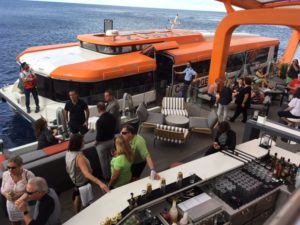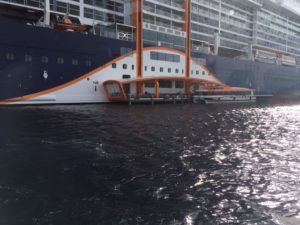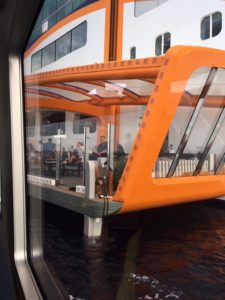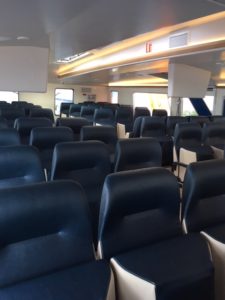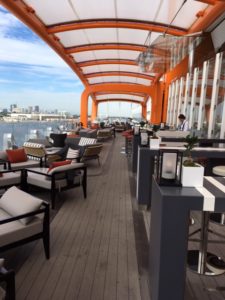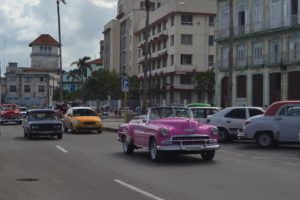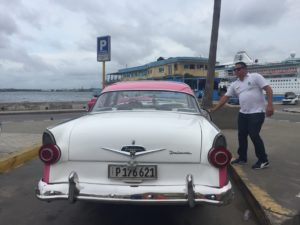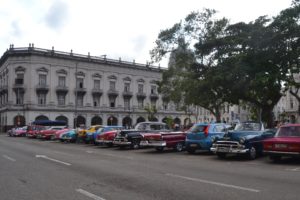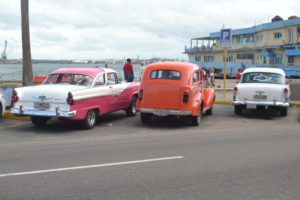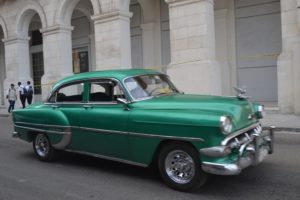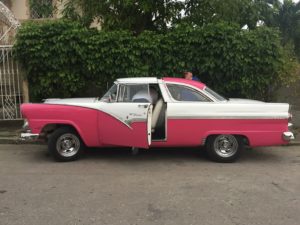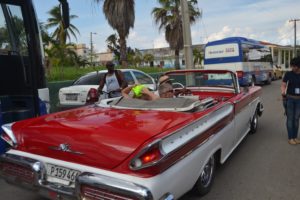Will the MAX 8 Be Safe When Ungrounded?
When we board an airplane, we all hope that we have a “Sully” Sullivan at the controls. Unfortunately, Sully has few equals. At age 12, he was accepted into Mensa, and later graduated from the Air force Academy as the top pilot. As a well-rounded young man in high school, he was first flutist in the school orchestra.
On our next flight, we could have a pilot who stayed up late watching a movie and was forth tubist. Hopefully, he isn’t suffering from a hangover. It happens. With a good but imperfect pilot, we want to fly on a plane as perfect as man can make. The Boeing MAX 8 could be that plane but currently falls far short of that lofty goal and upgraded software is not the answer.
According to data gathered by Airsafe.com, the 737 MAX is more than 25 times more likely to be involved in a fatal crash than the plane that is was designed to replace, the older versions of the 737. The MAX’s main competition, the Airbus 319neo, 320neo and 321neo, has had no fatal crashes. Why has the MAX been such a failure? Read the article below and you might come to the view that Boeing’s management decided that money trumps safety.
Several weeks ago, we said that we would never fly on a MAX 8 unless major structural changes were made and that it is our opinion that software changes are not the answer to a basic design problem.
A few weeks ago, we posited that we would never again fly on a Boeing MAX 8 or 9 aircraft unless structural changes were made to the plane before bringing it back into service.
It appears that Boeing Aircraft Company, in cahoots with the FAA, is going to rope-a-dope us with the quick and dirty software solution to fix their flawed MAX 8 plane and will not make the required structural changes. Software will not fix a basic design defect.
The following is an excerpt from an article by Matthew Yglesias of Vox News.
~ ~ ~ ~ ~ ~ ~ ~ ~ ~ ~ ~ ~ ~ ~ ~
Boeing’s effort to get the 737 Max approved to fly again, explained
A bigger problem than a software update.
By Matthew Yglesias Apr 5, 2019, 10:30am EDT
On Thursday, Boeing for the first time officially took responsibility for the two crashes of 737 Max jets that got the planes grounded by regulators.
Claiming responsibility was part of an attempt to get the planes approved to fly again. Boeing was trying to say that it now understands why the planes crashes — flawed software — and has a plan in place to replace it with new software that will eliminate the problem and persuade regulators to get the planes off the ground. But then Friday morning, the company announced that it had found a second, unrelated software flaw that it also needs to fix and will somewhat delay the process of getting the planes cleared to fly again.
All of which, of course, raises the question of why such flawed systems were allowed to fly in the first place.
And that story begins nine years ago when Boeing was faced with a major threat to its bottom line, spurring the airline to rush a series of kludges through the certification process — with an underresourced Federal Aviation Administration (FAA) seemingly all too eager to help an American company threatened by a foreign competitor, rather than to ask tough questions about the project.
The specifics of what happened in the regulatory system are still emerging (and despite executives’ assurances, we don’t even really know what happened on the flights yet). But the big picture is coming into view: A major employer faced a major financial threat, and short-term politics and greed won out over the integrity of the regulatory system. It’s a scandal.
The 737 versus 320 rivalry, explained
There are lots of different passenger airplanes on the market, but just two very similar narrow-body planes dominate domestic (or intra-European) travel. One is the European company Airbus’s 320 family, with models called A318, A319, A320, or A321 depending on how long the plane is. These four variants, by design, have identical flight decks, so pilots can be trained to fly them interchangeably.
The 320 family competes with a group of planes that Boeing calls the 737 — there’s a 737-600, a 737-700, a 737-800, and a 737-900 — with higher numbers indicating larger planes. Some of them are also extended-range models that have an ER appended to the name, and, as you would probably guess, they have longer ranges.
Importantly, even though there are many different flavors of 737, they are all in some sense the same plane, just as all the 320 family planes are the same plane. Southwest Airlines, for example, simplifies its overall operations by exclusively flying different 737 variants.
Both the 737 and the 320 come in lots of different flavors, so airlines have plenty of options in terms of what kind of aircraft should fly exactly which route. But because there are only two players in this market, and because their offerings are so fundamentally similar, the competition for this slice of the plane market is both intense and weirdly limited. If one company were to gain a clear technical advantage over the other, it would be a minor catastrophe for the losing company.
And that’s what Boeing thought it was facing.
The A320neo was trouble for Boeing
Jet fuel is a major cost for airlines. With labor costs largely driven by collective bargaining agreements and regulations that require minimum ratios of flight attendants per passenger, fuel is the cost center airlines have the most capacity to do something about. Consequently, improving fuel efficiency has emerged as one of the major bases of competition between airline manufacturers.
If you roll back to 2010, it began to look like Boeing had a real problem in this regard.
Airbus was coming out with an updated version of the A320 family that it called the A320neo, with “neo” meaning “new engine option.” The new engines were going to be more fuel-efficient, with a larger diameter than previous A320 engines, that could nonetheless be mounted on what was basically the same airframe. This was a nontrivial engineering undertaking both in designing the new engines and in figuring out how to make them work with the old airframe, but even though it cost a bunch of money, it basically worked. And it raised the question of whether Boeing would respond.
Initial word was that it wouldn’t. As CBS Moneywatch’s Brett Snyder wrote in December 2010, the basic problem was that you couldn’t slap the new generation of more efficient, larger-diameter engines onto the 737.
One of the issues for Boeing is that it takes more work to put new engines on the 737 than on the A320. The 737 is lower to the ground than the A320, and the new engines have a larger diameter. So while both manufacturers would have to do work, the Boeing guys would have more work to do to jack the airplane up. That will cost more while reducing commonality with the current fleet. As we know from last week, reduced commonality means higher costs for the airlines as well.
Under the circumstances, Boeing’s best option was to just take the hit for a few years and accept that it was going to have to start selling 737s at a discount price while it designed a whole new airplane. That would, of course, be time-consuming and expensive, and during the interim, it would probably lose a bunch of narrow-body sales to Airbus.
The original version of the 737 first flew in 1967, and a decades-old decision about how much height to leave between the wing and the runway left them boxed out of 21st-century engine technology — and there was simply nothing to be done about it.
Unless there was.
Boeing decided to put on the too-big engines anyway
As late as February 2011, Boeing chair and CEO James McNerney was sticking to the plan to design a totally new aircraft.
“We’re not done evaluating this whole situation yet,” he said on an analyst call, “but our current bias is to move to a newer airplane, an all-new airplane, at the end of the decade, beginning of the next decade. It’s our judgment that our customers will wait for us.”
But in August 2011, Boeing announced that it had lined up orders for 496 re-engined Boeing 767 aircraft from five airlines.
It’s not entirely clear what happened, but, reading between the lines, it seems that in talking to its customers Boeing reached the conclusion that airlines would not wait for them. Some critical mass of carriers (American Airlines seems to have been particularly influential) was credible enough in its threat to switch to Airbus equipment that Boeing decided it needed to offer 737 buyers a Boeing solution sooner rather than later.
Committing to putting a new engine that didn’t fit on the plane was the corporate version of the Fyre Festival’s “let’s just do it and be legends, man” moment, and it unsurprisingly wound up leading to a slew of engineering and regulatory problems.
New engines on an old plane
As the industry trade publication Leeham News and Analysis explained earlier in March, Boeing engineers had been working on the concept that became the 737 Max even back when the company’s plan was still not to build it.
In a March 2011 interview with Aircraft Technology, Mike Bair, then the head of 737 product development, said that reengineering was possible.
“There’s been fairly extensive engineering work on it,” he said. “We figured out a way to get a big enough engine under the wing.”
The problem is that an airplane is a big, complicated network of interconnected parts. To get the engine under the 737 wing, engineers had to mount the engine nacelle higher and more forward on the plane. But moving the engine nacelle (and a related change to the nose of the plane) changed the aerodynamics of the plane, such that the plane did not handle properly at a high angle of attack. That, in turn, led to the creation of the Maneuvering Characteristics Augmentation System (MCAS). It fixed the angle-of-attack problem in most situations, but it created new problems in other situations when it made it difficult for pilots to directly control the plane without being overridden by the MCAS.
On Wednesday, Boeing rolled out a software patch that it says corrects the problem, and it hopes to persuade the FAA to agree.
But note that the underlying problem isn’t really software; it’s with the effort to use software to get around a whole host of other problems.
Recall, after all, that the whole point of the 737 Max project was to be able to say that the new plane was the same as the old plane. From an engineering perspective, the preferred solution was to actually build a new plane. But for business reasons, Boeing didn’t want a “new plane” that would require a lengthy certification process and extensive (and expensive) new pilot training for its customers. The demand was for a plane that was simultaneously new and not new.
But because the new engines wouldn’t fit under the old wings, the new plane wound up having different aerodynamic properties than the old plane. And because the aerodynamics were different, the flight control systems were also different. But treating the whole thing as a fundamentally different plane would have undermined the whole point. So the FAA and Boeing agreed to sort of fudge it.
The new planes are pretty different
As far as we can tell, the 737 Max is a perfectly airworthy plane in the sense that error-free piloting allows it to be operated safely.
But pilots of planes that didn’t crash kept noticing the same basic pattern of behavior that is suspected to have been behind the two crashes, according to a Dallas Morning News review of voluntary aircraft incident reports to a NASA database:
The disclosures found by the News reference problems with an autopilot system, and they all occurred during the ascent after takeoff. Many mentioned the plane suddenly nosing down. While records show these flights occurred in October and November, the airlines the pilots were flying for is redacted from the database.
These pilots all safely disabled the MCAS and kept their planes in the air. But one of the pilots reported to the database that it was “unconscionable that a manufacturer, the FAA, and the airlines would have pilots flying an airplane without adequately training, or even providing available resources and sufficient documentation to understand the highly complex systems that differentiate this aircraft from prior models.”
The training piece is important because a key selling feature of the 737 Max was the idea that since it wasn’t really a new plane, pilots didn’t really need to be retrained for the new equipment. As the New York Times reported, “For many new airplane models, pilots train for hours on giant, multimillion-dollar machines, on-the-ground versions of cockpits that mimic the flying experience and teach them new features” while the experienced 737 Max pilots were allowed light refresher courses that you could do on an iPad.
That let Boeing get the planes into customers’ hands quickly and cheaply, but evidently at the cost of increasing the possibility of pilots not really knowing how to handle the planes, with dire consequences for everyone involved.
~ ~ ~ ~ ~ ~ ~ ~ ~ ~ ~ ~ ~ ~ ~ ~
What do you think? Is Boeing guilty of criminal negligence or good bottom-line business practices?
737 MAX 8 – Opinion from Just Cruises Plus
The 737 MAX 8 is a new plane and it should not be crashing. Why has it crashed twice in the last 6 months?
The 737 MAX, due to the placement of its engines, has a tendency to raise its nose. This requires adjustments to control surfaces to bring the plane to level flight. No other plane, including earlier 737s, has this tendency. Software won’t change this.
Boeing is between a rock and a hard place. They have to decide whether to do the right thing and make major structural changes which will cost a great deal of money and put them at a disadvantage to competitor, Airbus, but will fix the problem. Alternately, they can try to rope-a-dope the world into believing that software changes and more pilot training will fix the problem. If they do this, you will have to decide whether to fly on the second most dangerous commercial jet ever built by a North American or European country. I definitely won’t fly on it.
Celebrity Cruises Excursion and Specialty Dining Super Sale
Celebrity Cruises Excursion and Specialty Dining packages Super Sale – Must book by Tuesday, February 5th
Valid for select sailings between March 1st 2019 and March 28th 2020.
Book your excursions by Tuesday, February 5th and get up to 20% off on selected excursions.
Book a Specialty Dining TRIO Package and get 20% off*
* excludes Edge and holiday sailings.
Cruises to Bermuda and New England where all the Perks are Free
The Cruises
May 26th 10 nights – Celebrity Summit with stops at Bermuda (2 nights), Boston and Bar Harbor
June 5th 11 nights – Celebrity Summit with stops in Newport, Portland, Bar Harbor, Boston and Bermuda
June 16th 11 nights – Celebrity Summit with stops in Bermuda (2 nights), Boston, Bar Harbor and Portland
June 27th 10 nights – Celebrity Summit with stops in Sydney (Nova Scotia), Halifax (Nova Scotia), Bar Harbor, Boston (4th of July Fireworks in Boston Harbor), Portland
July 28th 7 nights to Bermuda
August 4th 7 nights to Bermuda
The Perks = approximately $1000 per person for 10 and 11 night cruises
Free Beverage Package
Free $300 per stateroom ship-board credit
Free Gratuities
Unlimited Internet for one device
The “Catches”
Valid until Thursday, January 31st – Extended to Thursday, February 7th
Non-refundable deposit
Inside staterooms are not included
Call Just Cruises Plus at 215-364-3310 or email us at justcruisesplus@comcast.net for prices and availability
Big News from Royal Caribbean
The Oasis of the Seas is coming to Cape Liberty, New Jersey in 2020. Until now, this class of ship could not sail from Cape Liberty because it is too tall and could not get under the very high Verrazano Bridge. Most sailings will be 7 nights to the Bahamas although there will be 2 short sailings to Canada in June of 2020. If you would like more information, call Just Cruises Plus (215) 364-3310 or email us at info@justcruisesplus.com.
Terry on Celebrity Edge
Terry is on the edge. Actually she is on the Celebrity Edge, the brand new Celebrity cruise ship. Celebrity Cruises invited Terry to sail on her inaugural cruise from the U.S. Terry has sent back amazing photos and we want to share some of them with you. The first ever “Magic Carpet” is the most notable of the many innovative features of the Celebrity Edge.
The Magic Carpet is a unique venue that changes mood, function and even its location as the world’s first cantilevered, floating platform. Terry’s first three photos show the Magic Carpet as the platform where you board a bucket-seated tender (third photo) when needed to reach an exotic shore. The fourth photo shows the Magic Carpet in its cafe form.
Edge will sail in the Caribbean during the winter months and then will move to Europe in the spring. If you want to be among the first to cruise on this amazing new ship, give us a call!
Magic Carpet as a tender boarding platform.
.
Magic carpet in its cafe form.
Only 5 percent of our clients do this. Do you?
Do you cruise in an inside stateroom? We doubt it. Only about 1 in 20 of our clients book an inside room. Before the cruise industry discovered balconies, cruisers could select ocean-view or interior rooms. More than 25% of our clients chose interior rooms. Since the introduction of balconies, cruise lines have had a hard time selling inside rooms. Even ocean-view rooms have become less popular (Princess has eliminated them on their newer ships).
Cruise lines hate inside rooms. They are far less profitable than balcony rooms. A typical example is the March 3rd sailing of the Crown Princess. An interior room is priced at $649 while a balconied room is $1499. Passengers in each get the same food, room service, entertainment and ports of call. You can see why cruise lines hate inside rooms. However, they are stuck with them. With every deck of balconies, there is interior space that needs to be filled, thus we have a surge in unwanted interior rooms.
How do cruise lines handle this problem? They offer extra discounts to the point that they are breaking even (or worse) on the sale of the interior rooms and are hoping that they make money with on-board spending. Note that many cruise lines do not give amenities to passengers who select interior rooms. They want these clients spending their own money. Celebrity Cruises is having an “Insider” sale of interior rooms (click for sale). If you’re one of the 5 percent who can live with an interior room, check out the Celebrity sale. It ends Monday.
Royal Caribbean has sharply reduced the number of interior rooms on their Oasis class ships using a very unique design. The Oasis Class ships are twice as wide as other cruise ships. This enabled the architects to build two superstructures on the double-wide hull. One side of each superstructure faces the ocean while the other side faces an open-air interior space. They put balconies on both the ocean-facing and the interior facing superstructures. In the interior facing space they created Central Park and Boardwalk. The balconies overlooking Central Park and Boardwalk command a much higher price than a traditional interior stateroom.
Call us on Monday if you’re interested in the Celebrity Insider’s sale.
Our Quick Visit to Cuba
Rachelle and Wayne couldn’t resist one of Royal Caribbean’s Going, Going, Gone sales. A four night cruise, with a full 12 hours in Cuba was only $349 for an ocean view room.
After a very leisurely sail from Miami to Havana, a distance of 99 miles, El Morro greeted us at the crack of dawn on the third day of the cruise. As we crept slowly toward our pier, we felt like we were entering the “Twilight Zone”. Roads along the shore side hosted US built cars from the 30s, 40s and 50s. Beautiful buildings came into view, many in poor condition after nearly 60 years of communist rule. We couldn’t wait to see more of this living museum.
When traveling to Cuba, you can’t simply get off the ship as you would in most ports. We had to take an excursion through Royal Caribbean thanks to new regulations promulgated by our government. Since one of Wayne’s favorite books is “The Old Man and the Sea”, we elected to take an excursion related to Ernest Hemingway. Our Cuban guide was excellent but the tour itself was just “OK”. Our friends who traveled with us took an Arts and Culture tour which they loved although they noted that there was a lot of walking. Folks with mobility issues should only take tours that involve motor transport. The streets in colorful Old Havana are either cobblestone or are in rough shape.
Once we completed the tour, our visa requirements were met so we were free to roam as we pleased. We negotiated a ride from the proud owner of a 1956 Ford Crown Victoria (stick shift) to take us to Jaimanitas on the outskirts of Havana where Cuban architect Jose Fuster constructed a dreamlike streetscape inspired by the works of Spanish architect Antoni Gaudy (Sagrada Familia in Barcelona).
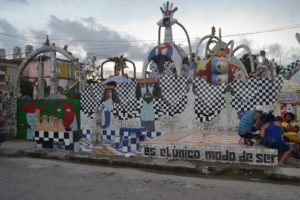
Main entrance to Fusterlandia
Many people ask us whether we felt safe. The answer is a clear “yes”. We walked through the crowded narrow streets of Old Havana totally at ease. We found the people to be exceptionally friendly although we must note that there are many new “entrepreneurs” selling food and various trinkets. They are not aggressive and a simple “no thank you” will suffice to get them to move on.
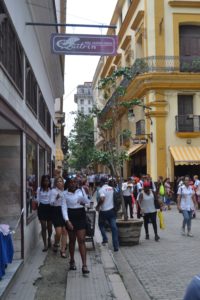 We ate lunch at a local waterfront restaurant (excellent food, so-so beer) and were serenaded by three fairly elderly male singers with musical instruments. They were not allowed in the restaurant so they played outside with a clear plastic sheet separating us. Three Cuban songs, including Guantanamera, charmed us into giving them a few dollars which they very much appreciated.
We ate lunch at a local waterfront restaurant (excellent food, so-so beer) and were serenaded by three fairly elderly male singers with musical instruments. They were not allowed in the restaurant so they played outside with a clear plastic sheet separating us. Three Cuban songs, including Guantanamera, charmed us into giving them a few dollars which they very much appreciated.
Other than traffic police, there were few police and we saw no soldiers. However, when getting off the ship and going through Cuban customs, we felt uneasy. The Cuban officials bordered on rude.
The money situation is slightly complicated and would be boring to read but if you intend to travel to Cuba, we will review it with you.
Right now Cuba is not for everyone. You must take a tour or cruise and engage in cultural or educational tourism. While Cuba has beautiful beaches, you’re not likely to sit on one sipping a daiquiri or Cuba Libra (both invented in Cuba). If you are a curious person, this should be on your future travel list. You’ll close your eyes and wake up in the 1950s.
More Car Photos From Our Trip
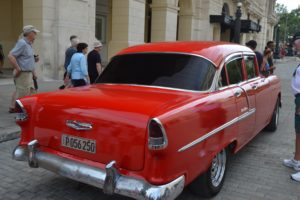
New Ship for Celebrity Cruises
Celebrity is building a ship specifically designed for the Galapagos Islands. The 100 passenger ship is the smallest ever built for Celebrity Cruises. The Ecuadorian government restricts the size ships that are allowed to visit these islands that are rich in wildlife seen exclusively in this part of the world. The ship will be named Celebrity Flora and will begin cruising in May of 2019.
This “soft adventure” cruise will be premium priced because this is one of the world’s most sought after destinations and government restrictions limit the number of visitors.
The Jones Act – How It Affects Your Cruise Price & Itinerary
The Jones Act has been in the news because of the hurricanes and the need to get supplies into hurricane ravaged US territories. It was enacted in 1920 and was designed to protect the American Merchant Marine which would be needed in time of war. Its basic tenant is that in order to carry goods or passengers between US ports, a ship must have the hull of the ship built in the US and at least 75% of its crew must be US citizens. During the ongoing emergency at St Thomas, St Johns and Puerto Rico, there are too few US flagged ships available to move supplies to these territories. Therefore the Jones Act was temporarily suspended.
How does the Jones Act affect the cruise industry and its customers?
There are a number of cruise lines whose ships ply US rivers who meet the Jones Act requirements. The most well known is the American Queen.
However, most of the large cruise ships were built in Europe and are flagged in small countries that have low tax rates. They cannot carry passengers between US ports without stopping at a foreign port. There is one large cruise ship that meets the Jones act provisions. It is NCL’s Pride of America. Its hull was built in the U.S. It’s flagged in the US and carries an American crew. It’s based in Hawaii has weekly cruises in the Hawaiian Islands.
It is the only large cruise ship that can do this itinerary and therefore it is no competition. NCL has the only 7 day cruise in the Hawaiian Islands.
How does the lack of competition affect price?
We compared a Balcony stateroom on a 7 day cruise around Hawaii with an NCL 7 day cruise to the Western Caribbean on the Norwegian Getaway. Royal Caribbean, Celebrity, Carnival, Princess and others provide stiff competition on this itinerary.
The lowest priced balcony on the March 3rd 2018 sailing of the Pride of America from Honolulu is $2599 per person while the lowest priced balcony on the March 4th Norwegian Getaway is $1179, less than half the price of the Pride of America.
Itineraries are also affected by the Jones Act. For example, for a round trip Alaska cruise from Seattle, one of the ports must be in Canada.
You can go to Hawaii on a cruise line other than Norwegian Cruise Line. However, the ship will stop in Ensenada or Vancouver on its way to or from the West Coast of the United States and it will be an 11 or 12 night cruise with a lot of days at sea..
Are there benefits to the Jones Act?
Yes, crews receive higher wages and working conditions are better and safer. Also, there are stricter environmental requirements for US flagged ships.
When NCL initiated Hawaii cruises on the Pride of America, they hired young Americans as waiters and room stewards and guess what happened? Passengers complained bitterly about the quality of service. It seems that the young Americans pictured themselves as laying out on deck during the day and partying at night with a smidgen of work here and there.
NCL had to build a facility in Maryland to train American staff in the art of service. They are now able to weed out the party people before they board the Pride and service is now very good.

